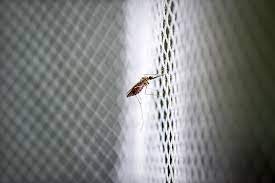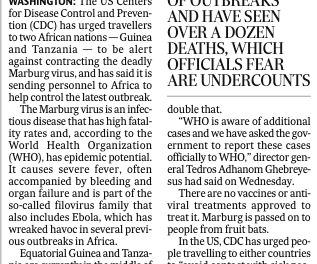Several new innovations aim to close gaps in anti-malaria efforts by targeting the mosquitoes that spread the disease.
Thanks, in part, to the wide deployment of these 2 WHO-recommended interventions, the world made remarkable gains against malaria in the period 2000–2015. But progress plateaued, and this troubling slowdown was exacerbated by COVID-19. According to WHO’s latest World malaria report, 2020 saw a rise in the global burden of malaria, with an estimated 627 000 deaths and 241 million new cases of the disease.
Getting back on track, and meeting WHO’s targets of a 90% reduction in malaria case incidence and mortality rates by 2030, will require renewed global attention, increased funding, and continued research and development of new interventions, among other actions. In the field vector control, researchers are working on several innovations that aim to enhance efforts to combat the disease.
Improved nets: expanding chemistries to defeat resistance
While insecticide-treated nets are already a key part of the anti-malaria tool kit, their effectiveness has diminished in recent years as mosquitoes have become resistant to pyrethroids, the only class of insecticides recommended by WHO, to date, for use in nets. Scientists are working to enhance pyrethroids’ lethality or find other more potent insecticides suitable for the treatment of nets.
Several new types of nets are now being tested that include a pyrethroid (still a highly potent mosquito killer) and an additional chemical, sterilizing agent, or insecticide. One recent large trial in the United Republic of Tanzania suggested that the new Interceptor G2 nets – treated with both a pyrethroid and chlorfenapyr, a different class of chemical not previously used for vector control – showed a marked improvement in preventing malaria over pyrethroid-only nets.
“It’s really encouraging to see these results from a very robust clinical trial,” says Dr Hilary Ranson of the Department of Vector Biology at the Liverpool School of Tropical Medicine. But “there is a huge variation in mosquito populations across Africa, and extrapolating from one setting to a whole continent is a big step,” she added. Another large trial of new nets in Benin should provide more results by the end of the year.
Attractive targeted sugar baits (ATSBs): taking the fight outside
Current vector control tools are indoor-centric. “Right now, we have a lot of products that are very effective for indoor use such as IRS and bed nets,” says Mathias Mondy, director of Business Development and Strategy at the Innovative Vector Control Consortium (IVCC), “but we are desperately lacking products to prevent outdoor transmission.” In 2014, IVCC requested new ideas for outdoor control. One company pitched the idea of attractive targeted sugar bait (ATSB), an outdoor bait station to attract and kill mosquitoes.
An ATSB station is the size of an A4 sheet, with small pouches containing a sugary matrix laced with insecticide. The bait is covered by a soft black membrane that allows mosquitoes to feed through while being protected against rain and dust. Two bait stations are placed at a height of 1.8 meters on outside walls of every house, so they’re kept out of reach of young children and animals.
/feature-stories/atsb.jpg?sfvrsn=a420b43f_3)
Attractive targeted sugar baits on a wall in Siaya County, Kenya. © IVCC
ATSBs are currently being tested in Mali, Zambia, and Kenya and have already shown great promise, while being much less arduous than spraying. “Compared to IRS,” notes Mondy, “it is much simpler to train health workers to nail ATSBs on the sides of houses.” Full results are expected by 2025.
Spatial repellents: reaching mosquitoes in the air
Another innovation that could alleviate some of the burdens of indoor spraying is spatial repellents, which release volatile chemicals into the air that change mosquito behaviour. “With IRS,” says Dr Nicole Achee, a medical entomologist at the University of Notre Dame, “mosquitoes have to lay or rest on a chemically treated surface” to be affected. But with spatial repellents, they “interact with chemicals in the air that have dispersed throughout the treated area.”
Spatial repellents carry other advantages too. They can be distributed on a surface that is as small as a sheet of paper – no fire or electricity required. “This might be something you put in a box on a bicycle and easily deliver to a community,” says Achee. They also last much longer than traditional repellents and don’t need to be frequently reapplied like topical anti-mosquito products. And like ATSBs, spatial repellents, once they have received a WHO recommendation, could be used by anyone to protect against malaria and diseases such as dengue, as long as instructions on proper use are followed.
Endectocides: humans as vector control
We have to throw the kitchen sink at malaria. If you’re only doing one thing and resistance pops up, you’ve lost everything. But when you have multiple interventions out there, it protects the progress that we’re making.
Another new frontier is endectocides or drugs that, when ingested by humans, exert an effect on mosquitoes that bite them. Originally used to treat onchocerciasis, ivermectin – the most studied endectocide to date – also seemed to have an adverse effect on mosquitoes. “If mosquitoes were captured that had fed on people given ivermectin, they did not survive very well,” says Dr Sunil Parikh, Associate Professor of Epidemiology and Infectious Diseases at the Yale School of Public Health.
For ivermectin to effectively control mosquitoes, however, humans would have to take a higher or more frequent doses than used for deworming. Pilot studies suggest that giving humans ivermectin more frequently might curb the mosquito population enough to reduce malaria transmission, and other studies have found the drug can be safely taken at higher doses. Several larger studies are now under way to confirm those results and to investigate other potential endectocides.
“What’s exciting about endectocides,” says Dr Parikh, “is that the person is essentially walking around with something in their blood that is lethal to mosquitoes that bite indoors, outdoors, daytime, night-time. So, you potentially have an impact on mosquitoes of many different flavours and habits.”
Gene drive: changing mosquito DNA
While field trials are still several years away, another intriguing new approach is genetic modification of mosquitoes. “Genetic changes are made specifically in the malaria vector to reduce malaria transmission,” explains Dr Mike Santos, Director of GeneConvene, a global collaborative focused on genetic biocontrol technologies for public health.
Once released into the wild, these genetically modified mosquitoes would pass on their changes to other malaria vectors. Dr Mamadou Coulibaly, principal investigator at Target Malaria, explains one such approach: “If you release a male mosquito that has this gene drive technology, it will impair the fertility of the female when it mates, so there’s no progeny and the population is reduced.”
/feature-stories/larva-study-lshtm.jpg?sfvrsn=b3011df5_2)
Research on gene drive technology for vector control. © Imperial College, London
The great advantage of gene drive approaches to vector control is their area-wide effect. Gene drive technology might someday play a particularly important role in hard-to-reach areas, where it may be difficult to deploy other malaria control tools as effectively, notes Santos. Coulibaly agrees: “It doesn’t discriminate between poor and rich. Once the technology is employed, it can do the job wherever mosquitoes are.”
For now, gene drive is being tested only in large-scale laboratory experiments. But Coulibaly hopes after further study it too can help stop malaria’s spread. “This is a new technology, and I cannot ask people to embrace it with closed eyes,” he says. “But this is also an opportunity to save more lives.”
VCAG: evaluating the science behind new innovations
Assessing the public health value of these and other new technologies is a key responsibility of WHO’s Vector Control Advisory Group, a body of scientists and researchers, including Dr Coulibaly and Dr Ranson, that works to independently assess efficacy data on new tools and approaches. The group advises WHO on the epidemiological impact of these tools which, once proven, will lead to a WHO recommendation to countries on their deployment.
No matter which technology they’re working on, every researcher agreed that no innovation is a silver bullet on its own. Rather, each should be seen as a complementary addition to a growing malaria control tool-box. “We have to throw the kitchen sink at malaria,” says Dr Parikh. “If you’re only doing one thing and resistance pops up, you’ve lost everything. But when you have multiple interventions out there, it protects the progress that we’re making.”











